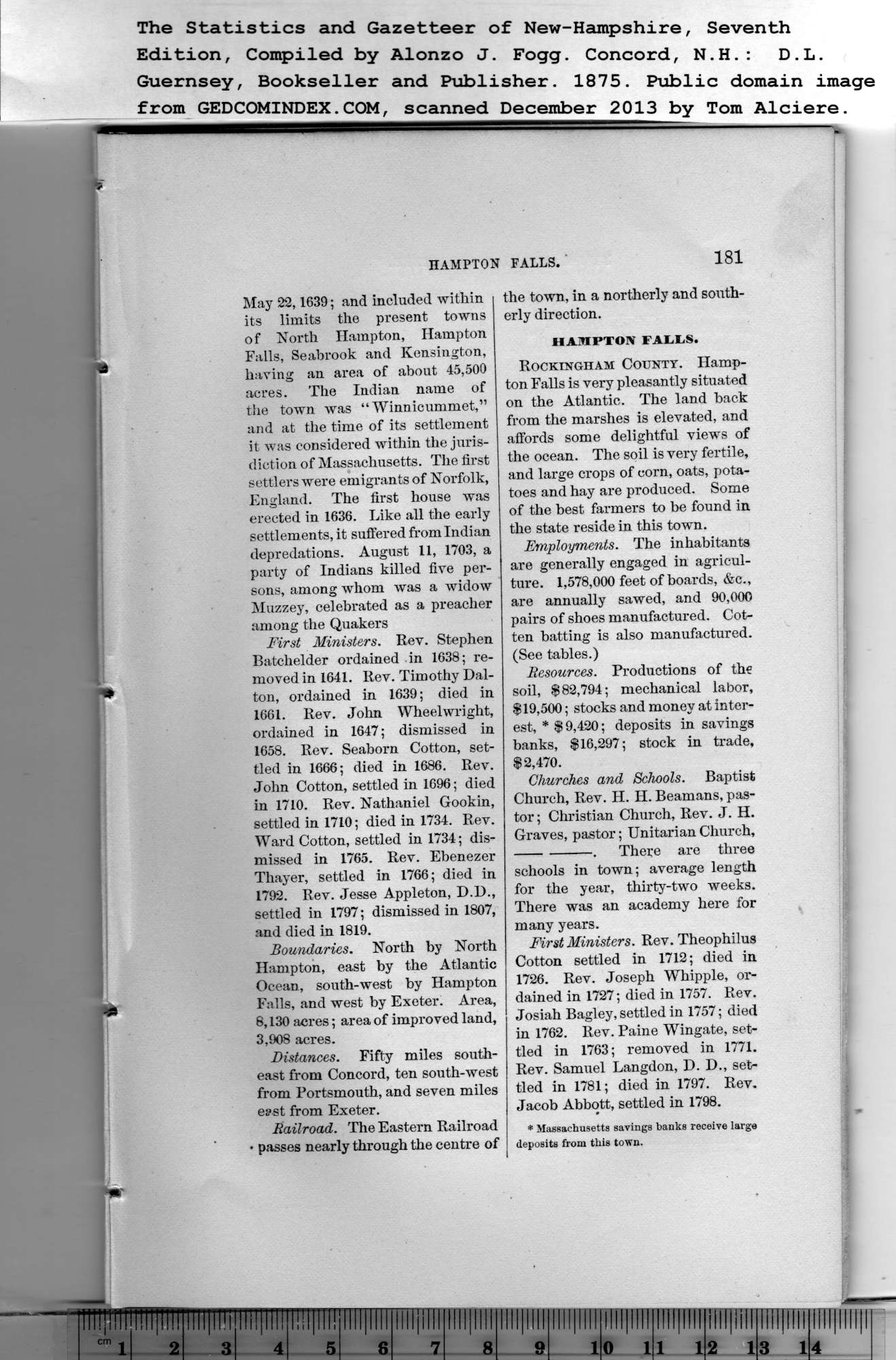|
May 22,1639; and included within
its limits the present towns
of North Hampton, Hampton
Fulls, Seabrook and Kensington,
having an area of about 45,500
acres. The Indian name of
the town was “ Winnicummet,”
and at the time of its settlement
it was considered within the juris-
diction of Massachusetts. The first
settlers were emigrants of Norfolk,
England. The first house was
erected in 1636. Like all the early
settlements, it suffered from Indian
depredations. August 11, 1703, a
party of Indians killed five per-
sons, among whom was a widow
Muzzey, celebrated as a preacher
among the Quakers
The Statistics and Gazetteer of New-Hampshire, Seventh
Edition, Compiled by Alonzo J. Fogg. Concord, N.H.: D.L.
First Ministers. Rev. Stephen
Batehelder ordained in 1638; re-
moved in 1641. Rev. Timothy Dal-
ton, ordained in 1639; died in
1661. Rev. John Wheelwright,
ordained in 1647; dismissed in
1658. Rev. Seaborn Cotton, set-
tled in 1666; died in 1686. Rev.
John Cotton, settled in 1696; died
in 1710. Rev. Nathaniel Gookin,
settled in 1710; died in 1734. Rev.
Ward Cotton, settled in 1734; dis-
missed in 1765. Rev. Ebenezer
Thayer, settled in 1766; died in
1792. Rev. Jesse Appleton, D.D.,
settled in 1797; dismissed in 1807,
and died in 1819.
Boundaries. North by North
Hampton, east by the Atlantic
Ocean, south-west by Hampton
Falls, and west by Exeter. Area,
8,130 acres; area of improved land,
3,908 acres.
Distances. Fifty miles south-
east from Concord, ten south-west
from Portsmouth, and seven miles
east from Exeter.
Railroad. The Eastern Railroad
passes nearly through the centre of |
181
the town, in a northerly and south-
erly direction.
HAMPTON FALLS.
Rockingham County. Hamp-
ton Falls is very pleasantly situated
on the Atlantic. The land back
from the marshes is elevated, and
affords some delightful views of
the ocean. The soil is very fertile,
and large crops of corn, oats, pota-
toes and hay are produced. Some
of the best farmers to be found in
the state reside in this town.
Employments. The inhabitants
are generally engaged in agricul-
ture. 1,578,000 feet of boards, &c.,
are annually sawed, and 90,000
pairs of shoes manufactured. Cot-
ten batting is also manufactured.
(See tables.)
Resources. Productions of the
soil, $82,794; mechanical labor,
$19,500; stocks and money at inter-
est, * $ 9,420; deposits in savings
banks, $16,297; stock in trade,
$2,470.
Churches and Schools. Baptist
Church, Rev. H. II. Beamans, pas-
tor; Christian Church, Rev. J. H.
Graves, pastor; Unitarian Church,
--. There are three
schools in town; average length
for the year, thirty-two weeks.
There was an academy here for
many years.
First Ministers. Rev. Theophilus
Cotton settled in 1712; died in
1726. Rev. Joseph Whipple, or-
dained in 1727; died in 1757. Rev.
Josiah Bagley, settled in 1757; died
in 1762. Rev. Paine Wingate, set-
tled in 1763; removed in 1771.
Rev. Samuel Langdon, D. D., set-
tled in 1781; died in 1797. Rev.
Jacob Abbott, settled in 1798.
* Massachusetts savings banks receive large
deposits from this town. |
